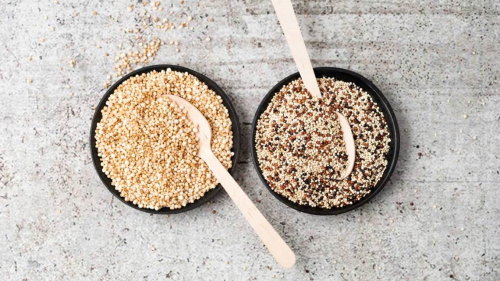Fonio is an African heritage grain — or ancient grain — that’s considered the continent’s oldest cultivated cereal.
Native to West Africa, it’s a staple most commonly enjoyed in the mountainous areas of countries like Burkina Faso, Guinea, Senegal, Mali, and Nigeria.
Other names for fonio include acha, iburura, and hungry rice.
This article explains the cultural significance, nutrients, and health benefits of fonio — and gives you several recipes to try.
Cultural significance of fonio
BREAKING: 1 Cup of This Melts Belly and Arm Fat (Take Before Bed)
In some parts of West Africa, fonio holds sociocultural significance.
In Senegal, Burkina Faso, Mali, and Togo, fonio was traditionally reserved for chiefs and royalty and enjoyed during the Muslim holy month of Ramadan or at celebrations like weddings and baptisms.
In some parts of Togo, fonio is used to prevent blood clotting after childbirth and stimulate milk production in breastfeeding people.
As a staple food, it plays a vital role in ensuring food security, especially during the post-harvest period when food is scarce. It can be harvested within 6–8 weeks and stores well without the risk of pest infestation.
Fonio grows well in drought conditions and poor soils without the need for fertilizers or other implements.
A neglected and underutilized crop species
Despite its rich cultural heritage and nutrient profile, fonio is considered a neglected and underutilized crop species (NUCS).
Sometimes referred to as “lost crops,” “minor crops,” or “orphan crops,” NUCSs haven’t been thoroughly researched, are utilized poorly, and largely grown by smallholder farms.
Yet, this tide is changing. Today, fonio is listed as a priority crop for West Africa. Due to its nutritional and environmental properties, as well as its potential to diversify one’s diet, it can be found in specialty food aisles and stores across the world.
Furthermore, fonio has become an important source of income for smallholder farmers in West Africa.
Are there different types of fonio?
A member of the millet family, fonio is divided into two main types:
- Digitaria iburua. This white grain has black or brown spikelets and grows mainly in parts of Nigeria, Togo, and Benin.
- Digitaria exilis. This white grain grows from Senegal to Chad, as well as in central Nigeria. It’s the most commonly eaten of the two varieties and more readily available outside Africa.
Fonio is a nutritional powerhouse
In addition to being naturally low in cholesterol, sodium, and fat, 1/4 cup (45 grams) of dry fonio — approximately 1/2 cup cooked — provides:
- Calories: 170
- Protein: 2 grams
- Sugar: 0 grams
- Fat: 0.5 grams
- Carbs: 39 grams
- Fiber: 4% of the Daily Value (DV)
- Iron: 4% of the DV
Fonio is a good source of B vitamins, including thiamine, riboflavin, and niacin, which are necessary for the growth, development, and function of cells, as well as energy production.
The United Nations Food and Agriculture Organization (FAO) suggests that fonio has the highest calcium content of all grains. This may make it a good choice for those who don’t consume dairy, such as vegans or individuals with lactose intolerance.
Fonio also provides iron, copper, zinc, and magnesium.
Iron and copper help form red blood cells, connective tissue, and blood cells, while zinc plays a role in immune function, protein synthesis, and cell growth and division. Magnesium aids numerous biochemical reactions and is required for energy production.
Health benefits of fonio
Although fonio has existed for over 5,000 years, scientific research on this grain is lacking (1).
Some studies suggest that the climate, soil conditions, and farming practices may affect the nutrient content of particular plant foods across Africa.
Great source of plant-based amino acids
Fonio is a good addition to the diets of people who don’t eat enough animal or protein-based foods.
Although its protein composition is comparable to that of white rice, fonio contains significantly higher amounts of the sulfur-containing amino acids methionine and cysteine. Both of these amino acids are lacking in grains like corn, wheat, rice, sorghum, and barley.
As an essential amino acid, methionine must be obtained through food, as your body can’t make it. It plays a role in skin elasticity, hair growth, nail health, and the growth and repair of body tissues.
Cysteine is a non-essential amino acid that’s necessary for protein synthesis and detoxification. It also plays a role in the formation of the amino acid taurine.
With the exception of lysine, a typical serving of fonio may meet about 10% of an adult’s daily essential amino acid needs.
Whole grain
Fonio is eaten in its entirety and therefore considered a whole grain.
Whole grains may aid weight management and gut health. They’re also associated with a plethora of health benefits, including a reduced risk of type 2 diabetes, heart disease, and colorectal, pancreatic, and stomach cancer.
Unlike refined grains in which the germ and bran are removed during processing, whole grains include all three parts of the kernel — the bran, endosperm, and germ.
According to the Whole Grains Council, a nonprofit consumer advocacy group, about 25% of a grain’s protein is lost when the bran and germ are removed. Nutrient losses also occur in many other important nutrients.
The U.S. Department of Agriculture (USDA) recommends that whole grains comprise half of your daily grain intake. Including 1/4 cup (45 grams) of dry fonio in your diet can help you meet that goal.
Gluten-free
Fonio is naturally gluten-free. Thus, it’s safe for people with gluten sensitivity or celiac disease.
Gluten-sensitive individuals may experience abdominal discomfort and tiredness when they eat foods that contain gluten — a group of proteins found in wheat, barley, and rye.
TRENDING: Doctors Can't Believe She Used This To Erase Her Wrinkles...
Among those with celiac disease, gluten presents the same symptoms as gluten sensitivity but also damages the small intestine.
May aid blood sugar management
Fonio contains resistant starch, which resists digestion and absorption in your small intestine..
Resistant starches have many health benefits and may play a role in increasing insulin sensitivity and lowering blood sugar levels.
Furthermore, this grain has a low glycemic index (GI) score, meaning that it doesn’t quickly raise your blood sugar levels. For this reason, it may help people with diabetes manage their blood sugar.
How to use fonio
Fonio is extremely versatile. When cooked, it has an earthy taste that readily absorbs the flavors of the foods it’s prepared with.
In West Africa, fonio is traditionally cooked as couscous, made into a porridge, and included in local beverages. Like other grains, it can be milled into a flour and used in baked goods, such as bread, cookies, and cakes.
In the kitchen, it’s so quick and simple to make that the Bambara people of Mali say that fonio never embarrasses the cook.
Don’t be afraid to experiment with it in your kitchen. Here are a few recipe ideas:
- Substitute fonio for any grain, including rice, couscous, millet, sorghum, quinoa, and barley.
- Use it in porridge in the same manner in which you’d use oats.
- Add it to soups and stews.
- Sprinkle it in salads.
- Use fonio flour in baked products like bread, cookies, cakes, and bars.
How to make fonio
- Bring 1 cup (240 mL) of water to a rapid boil.
- Add salt to taste.
- Add 1/4 cup (45 grams) of dry fonio, stir lightly, and cover.
- Turn the heat to low and cook it until all the liquid is absorbed.
- Turn the heat off and fluff the fonio with a fork.
- If the dish remains soggy, steam it further.
BREAKING: This Keeps Your Blood Sugar Below 100 - Even When You're Eating Sweets!
The bottom line
Fonio is an African heritage grain, also called an ancient grain, that’s mostly consumed in West African countries.
It’s naturally gluten-free and offers a robust amino acid profile, as well as other potential health benefits like improved blood sugar management.
Fonio is easy to prepare and culinarily versatile, making it a great fit for numerous savory dishes.









